Is Harvard Obeying the Supreme Court?
The numbers suggest that in 2024, Harvard ignored its 2023 loss in the highest court over its use of affirmative action in admissions.
Trump is currently waging war on Harvard, so let’s look at some data:
In the spring of 2023, Harvard, using affirmative action (as approved by the 1978 Bakke decision), admitted a freshman class that later that year it announced was 14% black. Similarly, Harvard’s neighbor MIT announced in 2023 that its new freshman class, no doubt admitted using affirmative action, was 15% black.
Then on June 29, 2023, the Supreme Court announced its 6 to 3 decision in Students for Fair Admissions v. Harvard that affirmative action in college admissions by institutions supported by federal money (i.e., almost all colleges other than Hillsdale and a few others) violates the equal protection clause of the 14th Amendment.
MIT responded to the Supreme Court’s announcement of the law of the land by slashing the black share of its freshman class from 15% in 2023 to 5% in 2024. That suggests MIT is still using affirmative action, but it also seemed like a reasonably respectful compromise response to the highest court.
Harvard, in contrast, responded to losing in the Supreme Court by admitting the same 14% black share of freshmen in 2024 as it had announced in 2023.
However, Harvard also announced that for methodological reasons that it didn’t fully explain, it had now discovered that, in retrospect, its black share in 2023 had actually been 18% rather than 14%, so its black share was actually cut from 18% in 2023 to 14% in 2024 following the Supreme Court’s decision. (When I try to reproduce Harvard’s arithmetic for 2023 under its purported new methodology, I only see a boost from 14.1% to, either, 14.7%, or at most, 15.3%. I go into more detail about Harvard’s methodological change below.)
The Trump Administration has cited SFFA, but has mostly so far called attention to alleged “anti-Semitism” at Harvard, which mostly seems to be, in practice, criticism of Israel, Israel’s policy, and Israel’s supporters.
Being criticized is unpleasant for most people (I’m more thick-skinned than most, but even I don’t like it), so it’s not surprising that there is a lot of a pushback against criticism of Israel. But we ought to try to keep things in perspective. Is Harvard anti-Semitic? Well, Harvard’s latest president, Alan Garber, is Jewish, as is the chair of the Harvard Corporation, Penny Pritzker.
As we can see with the recent assassination of two Jews in Washington D.C., criticism of Israel can lead to bad things.
But so did the Black Lives Matter movement’s criticism of the police, which led to at least ten assassinations of cops by BLM supporters in 2014-2016 (two in New York, five in Dallas, and three in Baton Rouge).
And it would be wrong to outlaw the expression of pro-BLM views, even after President Barack Obama’s 2016 speech credulously recounting BLM statistical talking points about racial disparities in criminal justice was followed just hours later by a black man murdering five policemen (and wounding eight others) at the BLM protest in Dallas.
As for Trump’s general attack on Harvard, allow me to recommend free speech activist and Harvard professor Steven Pinker’s highly sensible op-ed in the New York Times today.
Tearing down Harvard is a classic example of the Chesterton’s Fence problem. As G. K. Chesterton wrote in 1929:
In the matter of reforming things, as distinct from deforming them, there is one plain and simple principle; a principle which will probably be called a paradox. There exists in such a case a certain institution or law; let us say, for the sake of simplicity, a fence or gate erected across a road. The more modern type of reformer goes gaily up to it and says, “I don’t see the use of this; let us clear it away.” To which the more intelligent type of reformer will do well to answer: “If you don’t see the use of it, I certainly won’t let you clear it away. Go away and think. Then, when you can come back and tell me that you do see the use of it, I may allow you to destroy it.
At age 389, Harvard is just about the oldest fence in America.
As Pinker writes:
Just as clear is what won’t work: the Trump administration’s punitive defunding of science at Harvard. Contrary to a widespread misunderstanding, a federal grant is not alms to the university, nor may the executive branch dangle it to force grantees to do whatever it wants. It is a fee for a service — namely, a research project that the government decides (after fierce competitive review) would benefit the country. The grant pays for the people and equipment needed to carry out that research, which would not be done otherwise.
For example, I’m probably alive today because a number of elite universities, such as Stanford, received federal support to, first, do basic science research into monoclonal antibodies, and then to do applied science research into using one MAB (Rituxan) to treat non-Hodgkin’s lymphatic cancer.
Perhaps there is a better possible institutional arrangement for doing cancer research, but setting one up would take many years, so it would be inadvisable to tear down the one we have right now with nothing ready to replace it.
Is taking a chainsaw rather than a scalpel to Harvard good politics?
Perhaps, but it’s likely to alienate, say, cancer patients and their loved ones.
Here’s my paywalled Substack post from September 11, 2024 on post SFFA v. Harvard college admissions:
Battle of Cambridge: Harvard keeps quotas, doesn't follow MIT's compromise
Supreme Court be damned: Harvard announces blacks make up 14% of its new freshmen, same as it announced last year.
Last year, Harvard’s administration announced that its freshman class of 2027, the last let in before the Supreme Court ruling in the summer of 2023 that Harvard’s use of affirmative was unconstitutional, was 14% black, even though Harvard internal documents disclosed in the Students for Fair Admissions vs. Harvard lawsuit suggested that 1% or 2% would be the non-discriminatory figure.
Today, Harvard announced that it’s freshman class of 2028 is … 14% black.
Below the paywall, I present lots more data, including a discussion of how Harvard is claiming that, in deference to the Supreme Court, its 2023 black share was not the 14% its been telling everybody about since last year, but was always actually 18% (a figure nobody had ever heard before today). So, Harvard’s new narrative is that, in respect to the Supreme Court, Harvard actually cut its black share from 18% to 14%.
Also, I’m posting graphs on the share of the freshman class for Asians and Hispanics. Plus, I indulge in some hopefully amusing rank speculations about what is going on inside the heads of all the players in the Harvard quotas story.
In contrast to Harvard, way back on August 22, MIT fairly forthrightly led off this year’s Class of 2028 announcements by saying that its freshman class had dropped from 15% black to 5% black due to the Law of the Land.
In general, MIT has been taking the lead in American academia over the last couple of years in rolling back the worst excesses of Wokeness, such as DEI loyalty oaths and testing optional admissions. After a century and a half of playing subordinate to its neighbor Harvard, MIT seems to see an opening for global leadership just by acting reasonable. In contrast, traditional leader Harvard has hunkered down, appointing a Haitian lady of negligible academic accomplishment as its president, Claudine Gay, and only responding to MIT’s reforms grudgingly, if at all.
On the other hand, MIT’s share of blacks last year, 15%, was absurdly high for a rigorous STEM college:
So it’s possible that MIT cleverly let in some extra blacks in recent year in anticipation of Harvard losing in the Supreme Court, so that it could look in 2024 like it was taking the law very seriously by cutting blacks by two-thirds instead of more like by half versus its long-term race quota.
But, like I said, MIT is on a hot streak of acting intelligent.
As I mentioned above, Harvard also announced today that it had changed the methodology by which it counted the race/ethnicity of entering freshmen. And, lo and behold, last’s years Class of 2027 was now actually 18% black instead of 14% like it told the world a year ago.
So, Harvard actually cut its black share from 18% in 2023 to 14% in 2024.
The Harvard Crimson student newspaper tries to explain the statistical juggling going on in article that was updated over the course of Wednesday, probably to better emphasize the administration’s spin:
Harvard Reports Drop in Black Enrollment
The change in the demographic data for the Class of 2028 comes more than one year after the Supreme Court ruled Harvard’s race-conscious admissions practices unconstitutional.
By Elyse C. Goncalves and Matan H. Josephy
Updated September 11, 2024, at 12:32 p.m.
The number of Black students enrolled in Harvard’s Class of 2028 dropped by 4 percentage points compared with a year ago, offering the first indication of how the Supreme Court’s ruling against the College’s race-conscious admissions practices may transform the makeup of the student body.
The data released by the College on Wednesday revealed moderate, but notable changes in the demographic composition of the Class of 2028. The share of Black students declined to 14 percent from 18 percent. The proportion of Hispanic students in the Class of 2028 increased by 2 percentage points to 16 percent from 14 percent in the Class of 2027, while the proportion of students who identified as Asian American remained fixed at 37 percent.
Here’s the Crimson’s graph:
Note that Harvard never officially announces the white share of its freshman class:
Some things are just unmentionable in polite society.
After all, why do you want to know? Do you care about whites? Do you belong to some kind of organization that cares about whites? Everybody else at Harvard is encouraged to join their ethnic pressure groups, but a group that looks out for the interests of whites at Harvard would be unthinkable.
The Crimson tries to back out the white share by subtracting everybody else’s shares from 100%, but that only gives it what it calls “White/Other.” Does that include No Responses (which went up from 4% last year to 8% this year)? That’s vague. (And how many freshmen checked more than one race box? Presumably, non-citizen International freshmen aren’t being counted in either the numerator or the denominator.)
Anyway, the Crimson reports, for what it’s worth, that the “White/Other” category went up from 29% in the administration’s newly recalculated 2023 numbers to 32% in 2024.
And that leads into a whole can of worms: it turns out that the Harvard administration retconned its 2023 numbers today.
The Crimson article then changes its tune:
The demographic composition of the Class of 2028 is remarkably similar to last year’s group of freshman students who were admitted when the College still considered race in its admissions.
I’m guessing this paragraph was the original opening paragraph — the Crimson reporters presumably looked up their story from last year to get last year’s numbers: Whaddaya know? Blacks were 14% last year and they are 14% this year. There’s our big story. — but then the article was updated with the administration’s preferred spin: We didn’t tell anybody last year, but we actually were 18% black back then, so we aren’t totally spitting in the eye of the Supreme Court.
Though senior University administrators said the full effects of the Supreme Court decision will not be known for several more years, the data for the Class of 2028 fell short of the worst-case scenario that Harvard’s lawyers repeatedly warned of during the nine-year admissions trial. …
This year’s freshman class was admitted under Test Optional conditions. Harvard will soon follow MIT’s lead and go back to Test Mandatory applications. So that will make it harder to admit lots of blacks without obviously engaging in disparate impact discrimination.
Next, the Crimson tries to clear up the confusion about where the 18% figure suddenly came from:
Even as the data provided an initial sense of how the makeup of the College’s student body changed following the first admissions cycle without affirmative action, the numbers released by Harvard made it difficult to clearly compare the Class of 2028’s demographic data with previous years.
This year, the College changed its methodology for calculating demographic data as it saw a sharp rise in the number of students who opted to not disclose their race or ethnicity.
In the Class of 2028, 8 percent of students chose to not disclose their race or ethnicity, whereas only 4 percent of students in the Class of 2027 chose to not report their demographic information.
Last year’s freshman class had been told to answer the race/ethnicity question on their application for admission. Only 4% of the admitted freshman refused to do so. You want to play ball with the Harvard’s admission department. I mean, maybe they’ll take a shine to your principled non-conformity (Harvard actually likes letting in a few oddballs, such as a couple of dozen military veterans annually, to give flavor to the freshman class), but I wouldn’t count on it.
This year, 8% of the admitted freshmen refused, but they weren’t asked until they were already let in and thus had less (or nothing) to lose.
I’d imagine the thoughts that go through the heads of tired Harvard admissions staffers when they get an application with no race or ethnicity checked are something like this:
Oh, god, another one of these I Don’t See Race kids. No doubt an Asian or a white or a hapa. Maybe even a MAGA. If we let him in, he’ll probably quote Thomas Sowell in class. He might even ask why, if race is a social construct, the Harvard application asks your race? And some will demand to know why, if they can change their gender, they can’t change their race? Who needs the little creep? Look, we’ve got a job to do here in Admissions, which includes making sure there is a presentable level of diversity at Harvard. You’re not helping. REJECTED.
Also, this change in the point in the process when kids are asked about race probably depressed the number of kids who outright lied about their race in 2024, like Mindy Kaling’s brother did when getting in to med school, or who concocted far-reaching theories about why they deserve to self-identify as a favored race.
Imagine an Eduardo Saverin-type filling out his application before the Supreme Court’s decision and he comes to the race/ethnicity question:
Great-grandmother Alessandra came from the one of the oldest and best families in Rio de Janeiro, but there has always been some question about one of her 17th Century ancestresses, an adventuress of unusually obscure origins. Perhaps she was a mulatto or even a pardo? So, along with me being Latino (1/8th Brazilian makes you Latino, right? Maybe not Hispanic, but Brazil is definitely in Latin America), I guess I’m also black on my application! … Should I check American Indian as well? Are Amazonian natives American Indian? Is there a one drop rule for Indians? … Let me look this up … Oh, well, nobody even on College Confidential seems to know. … Nah, checking American Indian as well as black and Hispanic would be kind of pushing my luck, I guess. Going for the Privileged Race Hat trick might raise eyebrows in the Admissions office.
But this year, if Harvard’s already let you in, why bother asserting this far-fetched story when Harvard no longer asks you your race until after you are already assured of going?
Claiming to be black might someday lead to an African-American woman staffer at Harvard, one of those hard-staring Viola Davis-types, asking this white boy uncomfortable questions about my great-grandma, the Countess. So, why bother? I’ll just admit to being white. Or maybe I’ll take a principled stand and not answer their impertinent question.
On the other hand … what if in four years McKinsey is still hiring using quotas? Will they check with Harvard to see if I was black at Harvard like I’m telling them now I’m black? (McKinsey would probably love my story about the Countess: He’s rich and he’s Diverse!) Would Harvard tell them I wasn’t black at Harvard? They probably play ball with each other. I mean, there’s gotta be a reason McKinsey likes Harvard so much. … Who knows? Oh, man, it’s so complicated …
Has any famous research university ever published an audit of the truth of the race/ethnicity claims of its freshmen? That sounds like a fascinating and important topic, but there are certain questions research universities don’t research.
Instead of displaying the proportion of students who self-identify as a certain race or ethnicity out of the entire freshman class – as the College has done in the past — the percentages released this year were calculated out of the total number of students who chose to disclose their demographic information.
The result of this change was a broader discrepancy between numbers released by the College in the past and those referenced in their comparisons today.
Harvard reported last year in May that 29.8 percent of the Class of 2027 identified as Asian American, while 11.1 identified as Hispanic or Latino. Black students made up 14.1 percent of the class and 2.3 percent identified as Native American or Hawaiian.
In an effort to accurately compare the data released on Wednesday, Harvard’s Admissions Office released new numbers for the Class of 2027 that were calculated percentages out of the total number of students who disclosed their demographic information, according to a College spokesperson.
Got that?
Just because the Harvard administration cares about good data hygiene, they decided this week to revise their methodology just as they were about to report their most closely watched freshman class demographics ever: their response to losing in the Supreme Court. They could have done it last year or next year, but Good Methodology is too important to rush or delay.
Actually, I don’t see how this one minor methodological change could boost last year’s black share from 14% to 18%. It appears that last year, blacks made up 14% of 100%, but 4% of the 100% didn’t answer the question, so now Harvard is recalculating last year’s black share as actually being 14%/96% … which is 14.6%, not 18%.
What gives?
So, I’d imagine Harvard must have a few other tricks up its sleeve that’s getting last year’s figure all the way to 18%. Did they include International freshmen in last year’s denominator? Colleges don’t usually do that.
Anyway, it’s a pretty tedious topic. Congratulations to the Harvard Crimson reporters for getting into the weeds of it, even if they haven’t fully figured it out yet.
Here are graphs of other races’ shares using Harvard’s results announced in each year (i.e., not their recalculation for 2023). I got the old data from Web Archive so it reflects whatever Harvard announced that year, not what Harvard now claims it should have announced:
It’s pretty funny how Harvard obviously had a pretty strict quota of 1/8th for Hispanics until recently.
According to Harvard’s press release, Asians didn’t go up in 2024. But I go by what was announced at the time, not the retconning.
I’m subtracting all the mentionable groups from 100% to get a combination of The Great Unmentionables and whatever they are doing with No Responses. But who knows if this is a reasonable methodology.

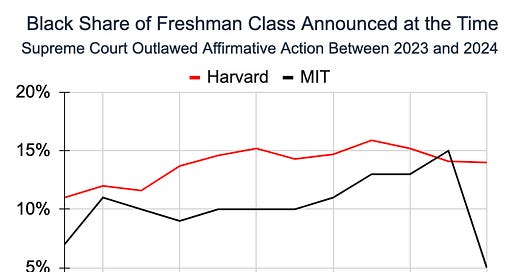



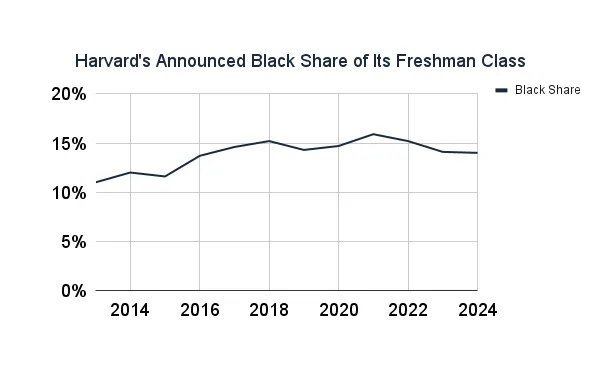
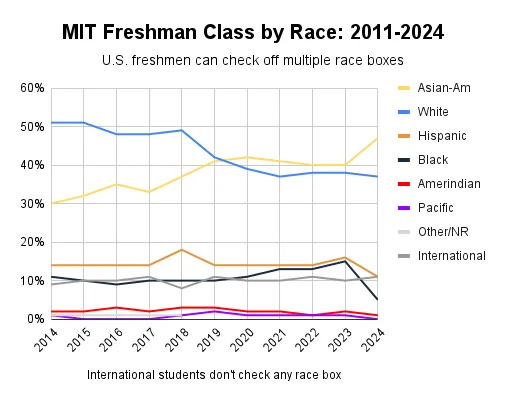
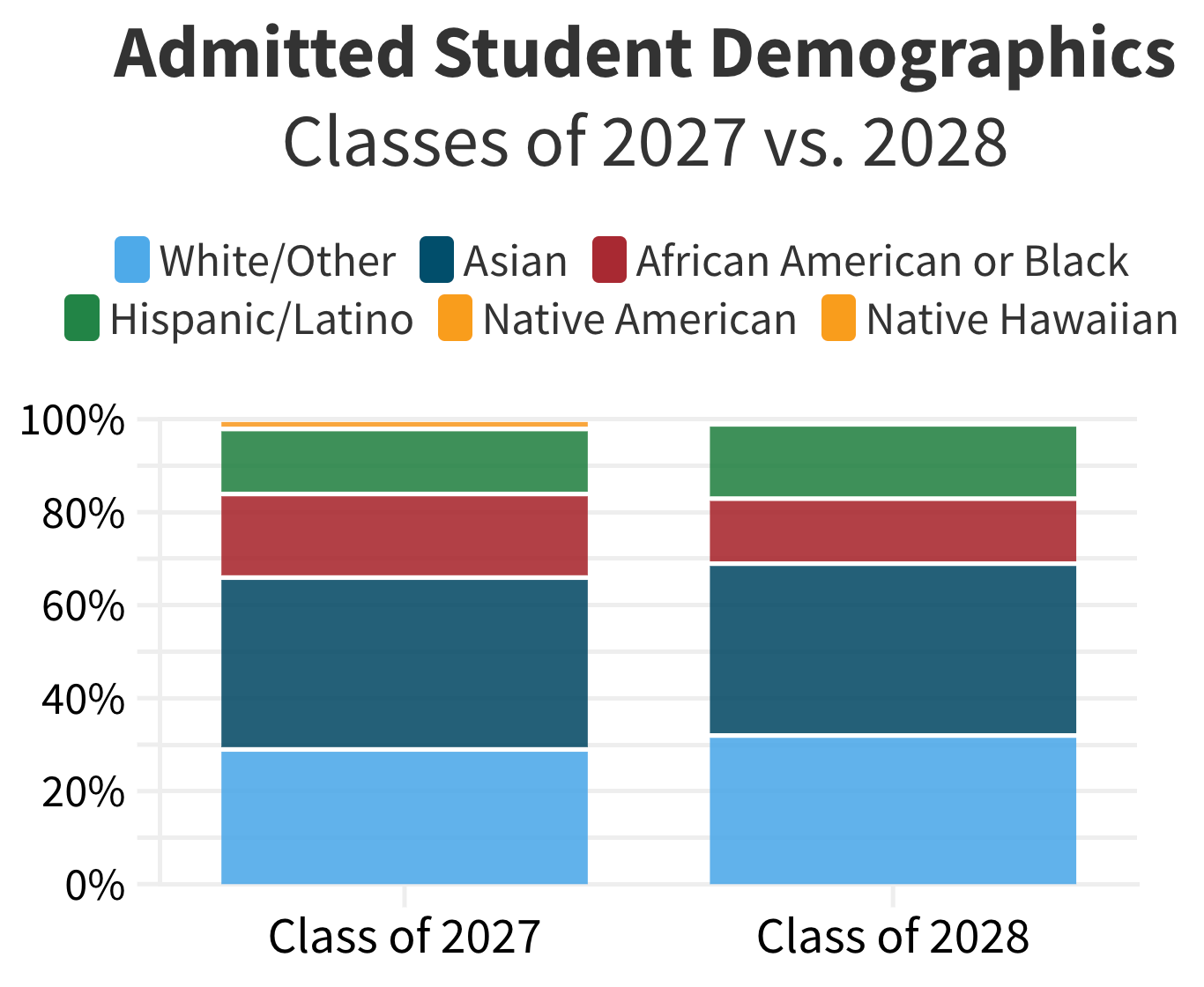
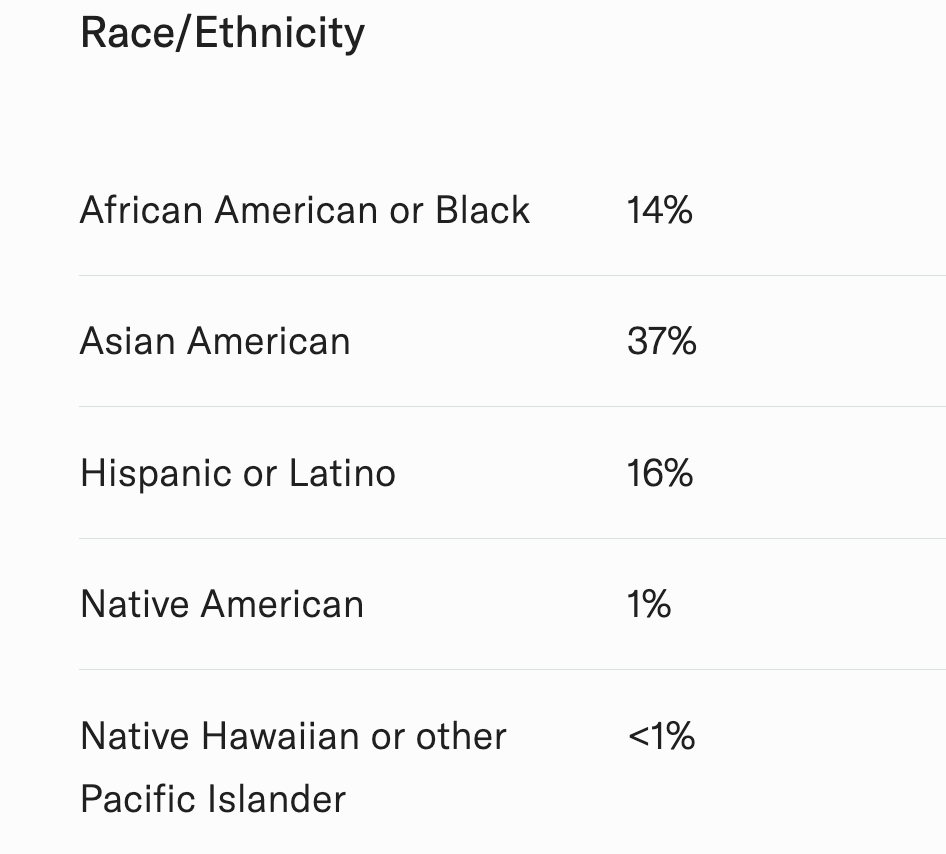
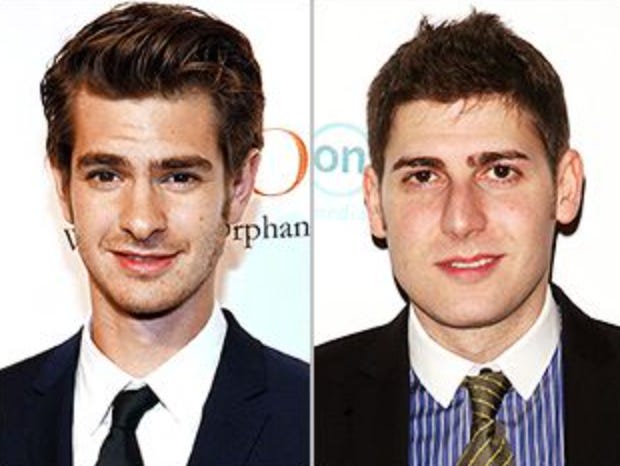
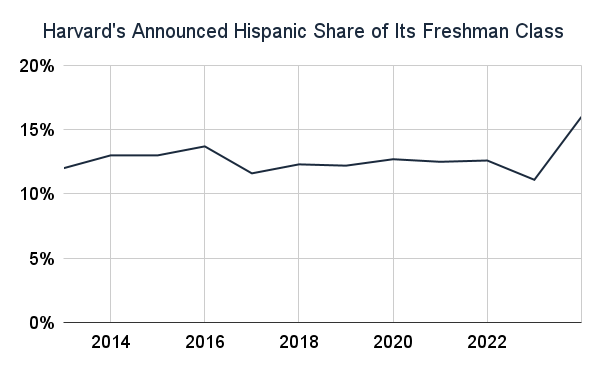
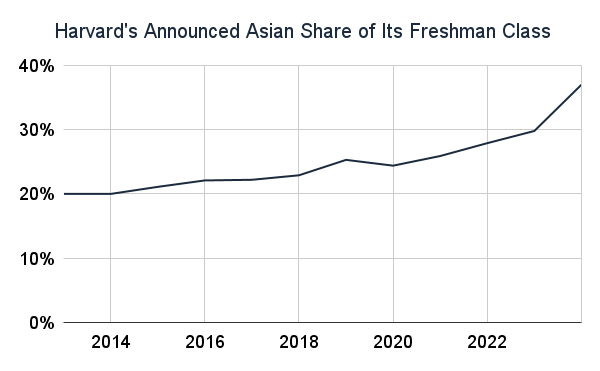
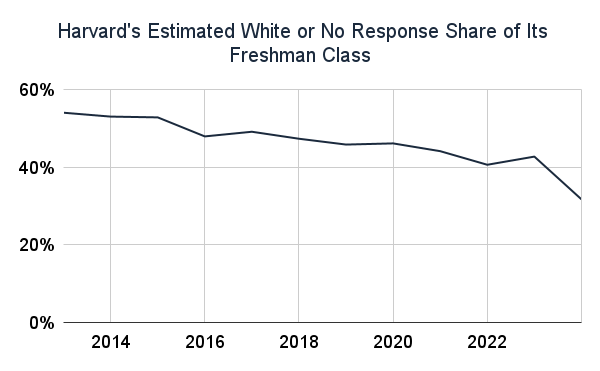
White saviorism/racial paternalism/social engineering by race/bureaucratized tokenism is foundational sacred dogma for gentry white liberals, it is their modern moral crusade and how they award themselves the divine right to rule and hog not only all the assets and power, but all the virtue too. THEY are the people who give a helping hand to the dark-skinned victim, unlike those crass and bigoted OTHER whites, their out-group, and even if your dark-skinned victim turns out to be wealthy like the Gay family of Haiti, that doesn't matter, only the symbol matters and its concomitant frisson of righteousness.
There is no Supreme Court decision, no lawsuit, no outrage, no referendum result, no meteor or earthquake that could ever change this, short of going full Eisenhower and sending the National Guard into the recruiting/admins office of every upscale institution in the country. (And even then they'd try to work around it.)
Anecdata lagniappe: my richest friend has a kid who's half Brazilian bc he married into a rich Brazilian family. For the kid's college admission application, he went with one of the family servants to a favela and made a "documentary" about their squalid sufferings and about how much he cares and wants to help. Ivy League material!
Notice that as soon as anyone talks about cutting federal funding, the first 100 things the universities will trot out are all "aristocracy of merit and accomplishment" STEM or STEM-adjacent, and never the endless stream of grievance studies slop and the work of all the vast armies of bureaucrats and petty-tyrant administrators that outnumber faculty and perhaps even students at this point. There is no good reason to bundle these things together anymore if the only defensible parts are held hostage as human shields against any effort for the public to use its right to allocate public monies to deal with the catastrophic degeneration of the rest.